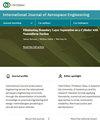新型eVTOL导管同轴螺旋桨悬停气动相互作用特性研究
IF 1.2
4区 工程技术
Q3 ENGINEERING, AEROSPACE
引用次数: 0
摘要
导管同轴螺旋桨(DCP)由于其安全性、紧凑性和低噪音水平,在eVTOL飞机的设计中具有很高的优势。为了研究DCP悬停时的气动特性,采用一种新型eVTOL,建立滑移网格模型求解三维非定常N-S方程。通过与自由同轴螺旋桨(FCP)和导管式单螺旋桨(DSP)的气动特性比较,揭示了导管与螺旋桨之间的非定常流动相互作用机理。结果表明,导管通过改变螺旋桨叶顶缠绕特性,显著减轻了叶顶涡强度,减少了相应的能量损失。此外,由于滑流区径向诱导速度的减小,静压损失也减小了。最后,轴向诱导速度的降低和尾迹收缩的抑制降低了诱导功率损失,使得DCP的气动效率比FCP高39%,风道占总升力的41.7%。虽然DCP产生的升力是DSP的1.77倍,但其气动效率仅为DSP的91.08%。本文章由计算机程序翻译,如有差异,请以英文原文为准。
Aerodynamic Interaction Characteristics Study of the Ducted Coaxial Propeller for a Novel eVTOL in Hovering
The ducted coaxial propeller (DCP) is highly advantageous in the design of eVTOL aircraft due to its safety, compactness, and low noise levels. To study the aerodynamic characteristics of DCP in hovering, a novel eVTOL was used, and a slip grid model was established to solve the three-dimensional unsteady N-S equation. The aerodynamic characteristics of DCP were compared to those of the free coaxial propeller (FCP) and ducted single propeller (DSP) to reveal the interaction mechanism of unsteady flow between the duct and propellers. The results indicate that the duct significantly mitigates the intensity of tip vortexes by changing the characteristics of propeller tip winding, which reduces the corresponding energy loss. Additionally, the static pressure loss is decreased by the reduced radical-induced velocity in the slipstream area. Finally, the induced power loss is reduced by the decreased axial-induced velocity and suppressed wake contraction, resulting in DCP having 39% higher aerodynamic efficiency than FCP and the duct accounting for 41.7% of the total lift. Although DCP generates 1.77 times more lift than DSP, its aerodynamic efficiency is only 91.08% of DSP.
求助全文
通过发布文献求助,成功后即可免费获取论文全文。
去求助
来源期刊

International Journal of Aerospace Engineering
ENGINEERING, AEROSPACE-
CiteScore
2.70
自引率
7.10%
发文量
195
审稿时长
22 weeks
期刊介绍:
International Journal of Aerospace Engineering aims to serve the international aerospace engineering community through dissemination of scientific knowledge on practical engineering and design methodologies pertaining to aircraft and space vehicles.
Original unpublished manuscripts are solicited on all areas of aerospace engineering including but not limited to:
-Mechanics of materials and structures-
Aerodynamics and fluid mechanics-
Dynamics and control-
Aeroacoustics-
Aeroelasticity-
Propulsion and combustion-
Avionics and systems-
Flight simulation and mechanics-
Unmanned air vehicles (UAVs).
Review articles on any of the above topics are also welcome.
 求助内容:
求助内容: 应助结果提醒方式:
应助结果提醒方式:


